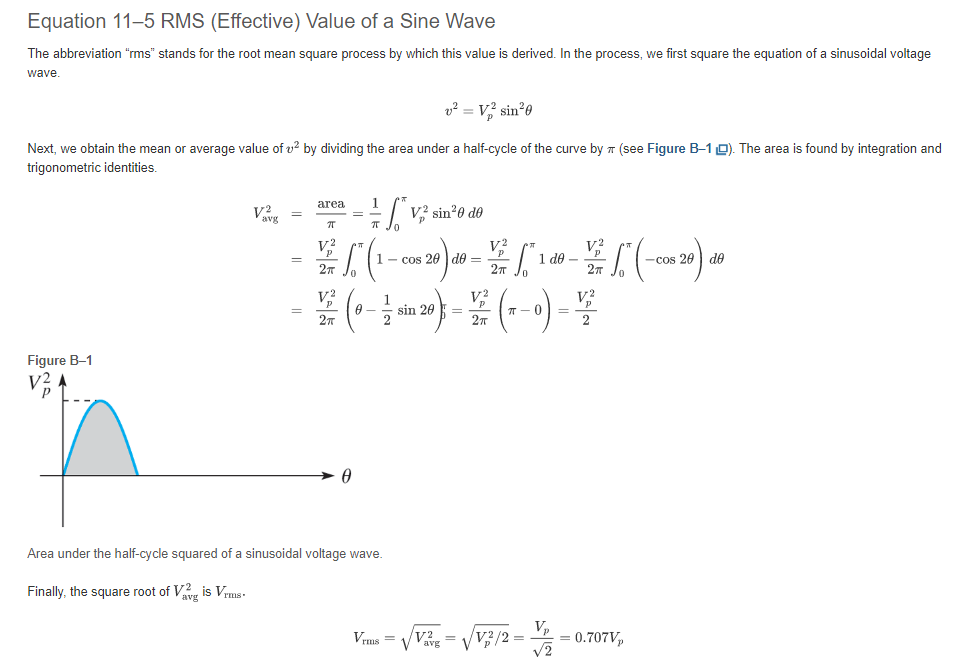Derive this relationship.
Introductory Circuit Analysis (13th Edition)
13th Edition
ISBN:9780133923605
Author:Robert L. Boylestad
Publisher:Robert L. Boylestad
Chapter1: Introduction
Section: Chapter Questions
Problem 1P: Visit your local library (at school or home) and describe the extent to which it provides literature...
Related questions
Question
100%
"Problem 1.
In your textbook, Equation 11-5 defines Vrms = 0.707 VPEAK . Derive this relationship."
See image of Equation 11-5. I don't remember how to do this. Please help! Please make legible, typed in equation form would be great. Thanks!

Transcribed Image Text:Equation 11-5 RMS (Effective) Value of a Sine Wave
The abbreviation "rms" stands for the root mean square process by which this value is derived. In the process, we first square the equation of a sinusoidal voltage
wave.
v² = V₂2² sin²0
Next, we obtain the mean or average value of ² by dividing the area under a half-cycle of the curve by (see Figure B-10). The area is found by integration and
trigonometric identities.
Figure B-1
V2
avg
=
area
π
V²
Vp
=
7T
V2
- (1 - 006 20) 40 - 1 0 - 2 (-00620) de
201
=
cos do
²5
-cos
2п Jo
2π
2T
1/V² sin²0 de
V2
1
V2
22 (0-20) = (1-0)-2
sin
=
2T
2π
0
Area under the half-cycle squared of a sinusoidal voltage wave.
Finally, the square root of Vis Vrms.
Vrms= /v²
Vavg=
Vp
V2/2 = = 0.707V₂
√2
Expert Solution
This question has been solved!
Explore an expertly crafted, step-by-step solution for a thorough understanding of key concepts.
This is a popular solution!
Trending now
This is a popular solution!
Step by step
Solved in 2 steps with 1 images

Recommended textbooks for you

Introductory Circuit Analysis (13th Edition)
Electrical Engineering
ISBN:
9780133923605
Author:
Robert L. Boylestad
Publisher:
PEARSON

Delmar's Standard Textbook Of Electricity
Electrical Engineering
ISBN:
9781337900348
Author:
Stephen L. Herman
Publisher:
Cengage Learning

Programmable Logic Controllers
Electrical Engineering
ISBN:
9780073373843
Author:
Frank D. Petruzella
Publisher:
McGraw-Hill Education

Introductory Circuit Analysis (13th Edition)
Electrical Engineering
ISBN:
9780133923605
Author:
Robert L. Boylestad
Publisher:
PEARSON

Delmar's Standard Textbook Of Electricity
Electrical Engineering
ISBN:
9781337900348
Author:
Stephen L. Herman
Publisher:
Cengage Learning

Programmable Logic Controllers
Electrical Engineering
ISBN:
9780073373843
Author:
Frank D. Petruzella
Publisher:
McGraw-Hill Education

Fundamentals of Electric Circuits
Electrical Engineering
ISBN:
9780078028229
Author:
Charles K Alexander, Matthew Sadiku
Publisher:
McGraw-Hill Education

Electric Circuits. (11th Edition)
Electrical Engineering
ISBN:
9780134746968
Author:
James W. Nilsson, Susan Riedel
Publisher:
PEARSON

Engineering Electromagnetics
Electrical Engineering
ISBN:
9780078028151
Author:
Hayt, William H. (william Hart), Jr, BUCK, John A.
Publisher:
Mcgraw-hill Education,